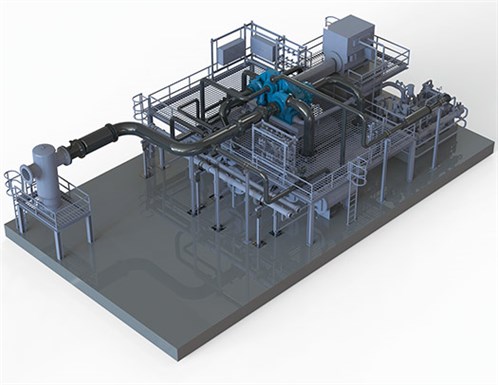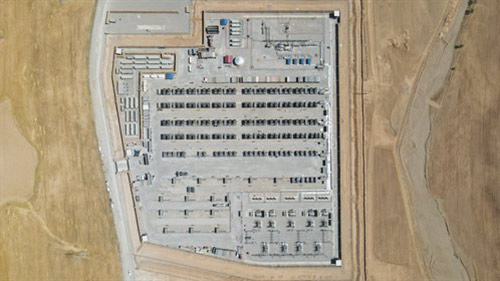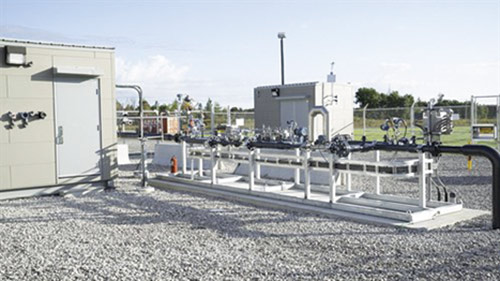New in Gas Processing Technology
Fincantieri begins construction on largest U.S. LNG barge
Fincantieri Bay Shipbuilding has begun construction on the largest LNG bunkering barge ever built in the U.S.
Bay Shipbuilding is expected to complete construction on the barge in late 2023 under contract with Crowley, the largest independent operator of tank vessels in the U.S. Crowley will operate the vessel under a long-term charter with Shell.
The 416-ft vessel, which will have the capacity for 12,000 m3 (3.17 MMg) of LNG, will be the largest Jones Act-compliant vessel of its kind, and the second Jones Act-compliant bunker barge Shell has under a time charter in the U.S.
Serving the U.S. East Coast, the vessel will be used to help expand current LNG network capacity and meet demands for cleaner energy sources for ships.
NEC, University of S. Alabama ink agreements on CO2 capture technology
Norton Engineering Consultants Inc. (NEC) has entered license agreements with the University of South Alabama (USA) to exclusively produce and supply non-volatile aqueous ionic amines (AIMs) for general use and to incorporate AIMs into processes for CO2 capture from combustion sources, including NEC’s proprietary flue gas scrubbing technology.
NEC and USA intend to introduce this technology to industrial clients in the oil refining, petrochemical, manufacturing and power industries to reduce emissions of CO2 and possibly other greenhouse gases (GHGs).
Gazprom completes feasibility study for Soyuz Vostok gas pipeline project
Gazprom has signed a statement on the results of the consideration of the feasibility study for the Soyuz Vostok gas trunkline construction project. As per the feasibility study, the pipeline will stretch for 962.9 km in Mongolian territory, the pipes will be 1,400 mm in diameter, and five compressor stations will be installed. The scope of works performed as part of the feasibility study, which includes the calculation of investment and operating costs, is extensive enough for the study to serve as front-end engineering and design (FEED) documents. Mongolian companies performed the required onsite surveys, engineering and environmental mapping and route analysis for the Soyuz Vostok project. The data obtained were used in the development of the gas pipeline route.
Linde Engineering begins plant for extracting H2 from natural gas pipelines
 |
Linde Engineering has started the world’s first full-scale pilot plant in Dormagen, Germany, to showcase how hydrogen (H2) can be separated from natural gas streams using Linde’s HISELECT powered by Evonik membrane technology.
The process is a key enabler for scenarios in which H2 is blended with natural gas and transported via natural gas pipelines. The blended gas can consist of between 5% and 60% H2. Membranes are then used to extract H2 from these natural gas streams at the point of consumption. The resulting H2 has a concentration level of up to 90%. When further processed with Linde Engineering’s pressure swing adsorption technology, a purity of up to 99.9999% can be achieved.
Atlas Copco to supply CO2 compressor to biofuels plant project in Europe
 |
Atlas Copco Gas and Process will be supplying CO2 compression equipment to a renewable biofuels plant project in Europe. The equipment will be used in an 820,000-tpy biofuels facility, located at the Shell Energy and Chemicals Park Rotterdam, the Netherlands.
The facility will be among Europe’s largest plants to produce sustainable aviation fuel (SAF), renewable diesel and renewable naptha made from biowaste. A facility of this size can produce enough renewable diesel to avoid 2.8 MMtpy of CO2 emissions, or the equivalent of taking more than 1 MM European cars off the roads.
In addition to the fuel production, an essential building block of Shell’s endeavor is the carbon capture and pipeline transport of CO2. A byproduct from different plant processes, including blue H2, the CO2 will be compressed to a pressure of 42.5 bar by the Atlas Copco Gas and Process’ five-stage turbocompressor. The machine is designed to compress 43.5 tph.
Expected to start production in 2024, the new facility will help both the Netherlands and the rest of Europe in meeting internationally binding emissions reduction targets. It will produce low-carbon fuels such as renewable diesel from waste in the form of used cooking oil, waste animal fat and other industrial and agricultural residual products, using technology developed by Shell.
Baker Hughes, EGPC to collaborate on flare recovery initiative
Baker Hughes has signed an MoU with the Egyptian General Petroleum Corp. (EGPC) that aims to establish and drive a flare recovery initiative to support emissions recovery and reduction across Egypt’s upstream and downstream oil and gas operations.
To enable flare recovery from oil and gas sites across Egypt, Baker Hughes will leverage its portfolio of emissions management solutions, including flare management technology, compression, gas turbines and integrated processing systems that can help in the measurement, management, recovery and utilization of flare gas.
In addition, Baker Hughes solutions—including flare.IQ—will contribute to digitalizing emissions management infrastructure by enabling EGPC to pull information about its flare systems to calculate optimum levels of flare efficiency and help reduce methane emissions.
NOVATEK, ENN ink sales and purchase agreement on long-term LNG supply
PAO NOVATEK’s wholly owned subsidiary, NOVATEK Gas & Power, and ENN LNG have signed a long-term LNG sale and purchase agreement (SPA) for the LNG produced from the Arctic LNG 2 project.
The SPA stipulates the supply of approximately 600,000 tpy of LNG from the Arctic LNG 2 project for a term of 11 yr. The LNG will be delivered on a delivered ex ship (DES) basis to ENN’s Zhoushan LNG Receiving Terminal in China.
Aggreko completes the Middle East’s largest flare gas-to-power project to date
 |
Aggreko has completed commissioning of the largest flare gas-to-power project in the Middle East to date. The plant is situated nearby the Saqala Field, Garmain block, Southeast Kurdistan.
The 165-MW modular power plant has run at full capacity for 72 hr in the project’s final site acceptance test, marking successful on-time, on-budget delivery. The plant is run on approximately 40 MMft3d of associated petroleum gas from the Saqala Field, saving 840 tpd of CO2 and cutting flaring by a third.
Enbridge Gas’ Canadian H2-blending project is fully operational
 |
Enbridge Gas, in partnership with Cummins Inc. and with support from Sustainable Development Technology Canada, the Canadian Gas Association and NGIF Capital Corp., has announced that its hydrogen (H2)-blending project is now fully operational and successfully serving the Markham, Ontario, community.
The $5.2-MM pilot-blending project involves enhancements to the existing Markham power-to-gas facility, which was built through a JV between Enbridge and Cummins in 2018 to help balance Ontario’s electricity supply and demand by storing the province’s surplus electricity as pure H2 until it is needed.
Through this project, clean H2 from the facility is now also being injected into a portion of Enbridge Gas’ existing natural gas system serving about 3,600 end users in Markham, Ontario. Blending H2 with traditional natural gas reduces GHG emissions, enabling lower carbon natural gas service delivery without impacting energy costs, reliability or safety.
This project will eliminate up to 117 tpy of CO2 emissions, moving the City of Markham further toward its objective of net-zero emissions by 2050.
Evonik has delivered SEPURAN membranes to more than 1,000 reference plants
Since the product launch in 2011, Evonik has delivered gas separation membranes to more than 1,000 reference plants worldwide as of the end of 2021. The company is experiencing continued demand in biogas, nitrogen (N2), hydrogen (H2) and natural gas applications. The expansion of existing production capacities at the Austrian site in Schörfling am Attersee is progressing.
At the heart of Evonik’s SEPURAN membrane technology are polymer-based, hollow-fiber membranes made of the high-performance polymer polyimide developed in-house. SEPURAN membranes make it possible to separate gases such as methane (CH4), N2 or H2 from gas mixtures. SEPURAN N2 membranes for efficient N2 generation are used, for example, to inert aircraft tanks. SEPURAN Noble membranes extract H2 transported through natural gas pipelines selectively from the CH4/H2 gas mixture at the delivery points. SEPURAN NG membranes enable efficient natural gas processing from gas sources with high CO2 concentration.
FERC updates policies to guide natural gas project certifications
The U.S. Federal Energy Regulatory Commission (FERC) issued two policy statements, providing guidance for future consideration of natural gas projects by the commission. These statements provide an analytical framework for many environmental and public interest issues that arise when companies seek to build new natural gas facilities. The certificate policy statement and interim GHG policy statement are intended to improve the legal durability of the commission’s natural gas certificate and LNG decisions following a series of court decisions raising concerns about the commission’s prior approach.
The updates to the certificate policy statement include the first revision in more than 20 yr to the commission’s policy for the certification of new interstate natural gas projects under Section 7 of the Natural Gas Act (NGA). With the interim GHG policy statement, the commission is taking a step in clarifying how it will address GHG emissions under the NGA and National Environmental Policy Act for proposed pipeline and LNG projects.
BASF signs a joint development agreement with China BlueChemical
BASF has signed a joint development agreement with China BlueChemical Limited Co., a leading natural gas producer, and the chemical engineering company Wuhuan Engineering to promote low-carbon development and utilization of marine gas resources. In the Dongfang Industrial Park of Hainan Province, China BlueChemical extracts large quantities of such offshore natural gas (marine gas) from gas fields in the South China Sea.
Marine gas, unlike the commercial natural gas, contains high concentrations of CO2. The gas requires CO2 removal to be usable for downstream large-scale applications. The process of separating CO2 from natural gas not only increases energy consumption, but also contributes to yield loss and direct carbon emissions. These issues limit the systematic development and utilization of natural gas with high CO2 content.
Through technical innovation in reforming catalysts, special reactor design and related process technology development, BASF’s solution will improve process energy efficiency and carbon efficiency beyond existing commercial catalyst and process technologies. The partnerships will promote lower-carbon development and utilization of marine gas resources, and ultimately achieve an economically competitive and environmentally friendly commercial process.
Saulsbury awarded cryogenic gas processing and terminal expansion projects
Saulsbury Industries, a national, full-service engineering, procurement and construction (EPC) company, has been awarded construction contracts with a major oil and gas producer for the installation of a new cryogenic gas processing facility in the Permian Basin. This facility, designed with a base-rated capacity of 200 MMsft3d, will be Saulsbury’s 63rd cryogenic processing facility over the last 15 yr, totaling more than 11 Bft3d of processing capacity. In conjunction, Saulsbury has also been selected to execute a major terminal expansion for the same client at a different location.
Saulsbury will be responsible for the turnkey construction of the processing facility that will include molecular sieve dehydration, cryogenic gas processing, refrigeration, residue gas compression and all balance of plant equipment, utilities, electrical, instrumentation and controls infrastructure. The terminal scope will include full construction services for the infrastructure supporting a major expansion to the existing storage capacity.
SC&T to provide Cansolv CO2 capture technology at VPI Immingham
Shell Catalysts & Technologies has been appointed by the Humber Zero project to provide the technology that will capture millions of tons of CO2 at the VPI Immingham combined-heat and power station in the UK.
Humber Zero is a multi-billion-pound project to decarbonize vital industry in the Immingham industrial area in northern Lincolnshire, on the south bank of the River Humber. The project will incorporate both post-combustion carbon capture and the production of H2 for energy.
Shell will provide its Cansolv CO2 post-combustion carbon capture technology to be retrofitted to the existing VPI Immingham power station stacks, which emit carbon-rich flue gas. Shell’s partner for Cansolv CO2 technology, Technip Energies, will support the design of the capture unit and the pilot plant. The technology will capture up to 95% of the CO2 in the gas, preventing it from being emitted to the atmosphere and allowing it to be compressed, transported and safely stored in geological structures under the seabed.
Air Liquide to build its largest biomethane production unit
Air Liquide continues its development of biomethane activities with the construction in the U.S. of its largest biomethane production unit in the world. This will bring the company’s worldwide biomethane production capacity to 1.8 TWh.
Located in Rockford, Illinois, the new production unit will produce biomethane from biogas from a solid waste treatment plant owned and operated by Waste Connections Inc. It will have a production capacity of 380 GWh/yr, which represents the largest production capacity per plant for the group. The facility will be operational by the end of 2023. GP




Comments